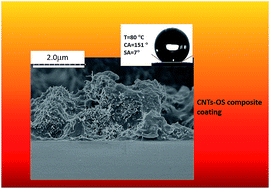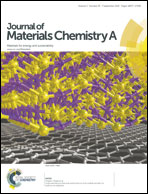Repelling hot water from superhydrophobic surfaces based on carbon nanotubes†
Abstract
Superhydrophobic (SH) surfaces generally refer to those having a static water contact angle larger than 150° and a slide angle less than 10°, when both the surface and the water droplet are at room temperature. Most such surfaces lose superhydrophobicity when exposed to hot (e.g., >55 °C) water. Our recently published results (Z. J. Yu, J. Y. Yang, W. Fang, Q. Ge, L.-L. Yang, Z.-L. Ding, D.-Q. Yang, E. Sacher and T. T. Isimjan, Journal of Materials Chemistry A, 2014, 2 10639) indicated that hot water superhydrophobicity is maintained when the SH surface temperature is higher than that of the water droplet. Here, we find that carbon nanotubes (CNTs) can be developed into SH surface coatings that repel hot water without any limitation to the surface temperature. Our SEM observations demonstrate that nanostructures formed by CNTs, contributing both a high porosity and a small water droplet contact area, will maintain superhydrophobicity even for hot water. In particular, a composite, made of CNTs and an organic silicone resin binder, shows both excellent hot water repellency and mechanical robustness, which, together, promise potential applications in hot liquid self-cleaning and high efficiency heat transfer.


 Please wait while we load your content...
Please wait while we load your content...